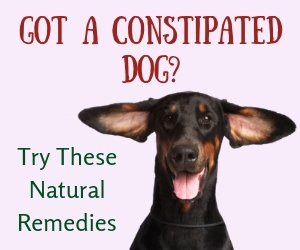Dog Anal Glands
(FTC Disclosure: If you make a purchase via a link on this page, I may receive a small commission, at no added cost to you.)

Dog anal glands ... not quite a savory topic, but anal gland problems, such as anal gland abscess and impacted anal glands, are rather common in dogs (especially among small dog breeds).
As dog parents, we should know how to deal with these gland problems.
What are Anal Glands?
Anal glands, or anal sacs, are a pair of small scent glands located on each side of a dog's anus, slightly below the anal opening, at about the 4 o'clock and 8 o'clock positions. They open to the outside by tiny ducts. The sacs contain a powerful, foul-smelling substance that contains pheromones.
In dogs, this substance is used primarily to mark territory, as a form of communication, or to express extreme fear.
Ordinarily, the dog anal glands are emptied out ("expressed") during defecation, when the pressure of the stool presses on the glands so that some of the secretion is deposited on the stool.
The secretion has a very strong distinct odor which is very unpleasant to us but was probably useful to dogs, especially in the past, for marking their territory and "communicating" to other dogs.
When Do You Need to Express a Dog's Glands?
If your dog is healthy, well-exercised, and on a natural well-balanced diet, chances are, he will have regular bowel movements, and his poop will most likely be firm enough to express the glands voluntarily.
Sometimes, for various reasons listed below, some dogs are unable to empty their glands on their own naturally.
This leads to build up and thickening of the secretion and clogging of the duct. The anal sacs become impacted. As you can imagine, this condition is very uncomfortable for dogs.
If your dog shows signs of having impacted anal glands, then you know you need to express his glands manually.
Impacted Anal Glands in Dogs
As mentioned above, when the anal glands become inactive and are not emptied out, the anal gland ducts may become clogged. The glands will then be overfilled with secretion, and a condition called "anal gland impaction" results.
Signs of Impacted Dog Anal Glands
- Dog constantly scooting along the floor in an attempt to empty the sacs, sometimes leaving behind unsightly brownish "skid marks"
- Dog constantly licking the anal area
- Some dogs may chase their tails
- Strong, foul fishy smell from the gland area
Common Causes of Impacted Anal Glands
Why do dogs' anal glands get full and become impacted? Here are some common reasons:
- Inappropriate diet - For example, a diet high in grains can cause inflammations of the GI tract because dogs cannot digest grains well. Grains can also often cause allergies in dogs. Allergies and inflammation of the GI tract can cause anal gland problems as well.
- Constipation or infrequent bowel movement.
- Stool too soft.
- Obesity - It is found that if a dog is too fat, the fat tissue surrounding the muscles in the anal area makes it more difficult for the anal glands to be expressed while the dog is pooping.
- Inadequate exercise.
- Stress - Frustration or stress in dogs very often results in soft stool. This in turn decreases anal gland expression.

Treatment - Expressing Dog's Anal Glands
Impacted dog anal glands can be emptied out manually by a veterinarian or a groomer. You can also try to do it yourself if you don't mind the smell!
Expressing your dog's anal glands is relatively easy (though not pleasant!) Here's how:
- Hold up the dog's tail and pull it gently upward.
- Hold a tissue with your free hand (preferably gloved), place your thumb over one anal gland and your fingers over the other (the glands are located on each side of the anus, slightly below the anal opening, at about the 4 o'clock and 8 o'clock positions).
- Press in - use gentle pressure - and squeeze like you are milking a cow.
To help increase blood flow and soften the tissues around the glands and thereby promoting expression of the sacs, try using a warm herbal compress before manually expressing them.
If you have herbal tinctures of Calendula, Chamomile, or Red Clover, add about one teaspoon of any of these tinctures to a quart of warm water.
Soak a small towel in the herbal solution and hold it to your dog's rear end for 5 minutes or so. After compression, express the glands manually as described above.
Depending on the dog, you may need to express the dog's glands several times before the sacs are emptied out. If you notice that your dog continues to scoot on the floor or lick himself even after sac emptying, check the anal sacs, and if necessary, express them again.
However, if the sacs are empty but scooting persists, it is likely that your dog has some other problems, e.g. tapeworm infestation, allergy, or even lower back pain.
Anal Gland Abscesses
 You may wonder why you need to express a dog's impacted glands.
You may wonder why you need to express a dog's impacted glands.
The reason is, if an impacted anal sac is not expressed, it may become infected and an abscess can form within the gland and rupture out through the skin. Sometimes, an infection can be caused by bacteria that have made their way into the glands, probably through the ducts.
When the abscessed material overflows the sacs, the skin over the sacs breaks open and the pus drains onto the skin. As you can imagine, this is a very painful condition for dogs.
Signs of An Anal Gland Abscess
- Swelling on either side of the anus
- Anal area becomes red (purple at a later stage)
- Pain, sometimes severe, near the tail or anus
- Dog constantly licking the anal area
- Dog may whimper with pain and discomfort
- Dog may develop constipation as the pain in his rear end deters him from relieving himself
Treatment
Conventional treatment of an anal gland abscess is to surgically lance, debride, drain and flush the sacs with an antiseptic solution, and administer antibiotics.
If you prefer to use a more gentle homeopathic treatment, discuss the problem with a holistic vet.
The common homeopathic remedies used to treat anal gland abscess include Belladonna and Silicea. Belladonna can reduce the intense pain whereas Silicea helps the discharge of pus and promotes healing.
Preventing Anal Gland Problems in Dogs
Healthy Foods
As mentioned above, a well-balanced, natural diet with high-quality protein and grain-free diet supplemented with probiotics and digestive enzymes is important.
Adequate Exercise
Regular exercise will also help the anal glands to empty naturally. If possible, take your dog out to exercise at least 15-20 minutes twice a day. Taking your dog out regularly also allows him to have frequent bowel movements.

Allergies and Dog Anal Glands
Some veterinarians suggest that anal sac problems in dogs may be related to allergies. If your dog has problems with his anal glands and he is constantly licking and scratching himself, it may be that the two problems are related - be sure to consult with your veterinarian.
In the meantime, give your dog some Omega-3 fatty acids, such as fish oil, to alleviate his itch and skin irritations.
Eldredge, et al. Dog Owner's Home Veterinary Handbook 4th edition (Wiley Publishing, 2007).
D. Hamilton, Homeopathic Care for Cats and Dogs (North Atlantic Books, 1999).
C.J. Puotinen, Natural Remedies for Dogs and Cats (Keats Publishing, 1999).
R.H. Pitcairn, The Complete Guide to Natural Health for Dogs and Cats (Rodale, 2005).





